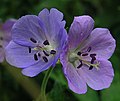Category:Geraniaceae
| Geraniaceae | |
|---|---|

| |
| Geranium rotundifolium | |
| Scientific classification | |
| Kingdom: | Plantae |
| Clade: | Angiosperms |
| Clade: | Eudicots |
| Clade: | Rosids |
| Order: | Geraniales |
| Family: | Geraniaceae Juss.[1] |
| Type genus | |
| Geranium | |
| Type species | |
| Geranium sylvaticum | |
| Genera | |
| |
Geraniaceae is a family of flowering plants placed in the order Geraniales. The family name is derived from the genus Geranium. The family includes both the genus Geranium (the cranesbills, or true geraniums) and the garden plants called geraniums, which modern botany classifies as genus Pelargonium, along with other related genera.
The family comprises 830 species in five to seven genera. Numerically, the most important genera are Geranium (430 species), Pelargonium (280 species) and Erodium (80 species).
Description
Geraniaceae are herbs or subshrubs. The Sarcocaulon are succulent, but other members of the family generally are not.
Leaves are usually lobed or otherwise divided, sometimes peltate, opposite or alternate and usually have stipules.
The flowers are generally regular, or symmetrical. They are hermaphrodite, actinomorphic (radially symmetrical, like in Geranium) or slightly zygomorphic (with a bilateral symmetry, like in Pelargonium). The calyx and the corolla are both pentamerous (with five lobes), petals are free while sepals are connate or united at the base. The androecium consists in two whorls of five stamens each, some of which can be unfertile; the pistil consists of five (less commonly three) merged carpels. The linear stigmas are free, and the ovary is superior. Flowers are usually grouped in cymes (e.g. in Geranium), umbels (e.g. in Pelargonium) or, more rarely, spikes.
Geraniaceae are normally pollinated by insects, but self-pollination is not uncommon.
The fruit is a unique schizocarp made of five (or three) achenes, in the lower part the achenes are inside the calyx, while the upper part (the stylar beak) is the style of the flower, looking like a kind of long beak over the achenes. When the fruit is mature the style breaks into five (or three) hygroscopically active (ready to absorb water) bristles that curl, causing the achenes to be released.
Taxonomy
Geraniaceae, with Francoaceae are the two families included in the order Geraniales under the Angiosperm Phylogeny Group (APG) classification (APG IV).[3] There has been some uncertainty in the number of genera to be included. Stevens gives seven genera listed here,[4] while Christenhusz and Byng[5] state five genera.
Stevens also lists four synonyms of Geranium: Geraniopsis Chrtek Neurophyllodes (A. Gray) O. Degener Robertianum Picard Robertiella
Hypseocharis, with between one and three species, which comes from the south-west Andean region of South America, is considered the sister to the rest of the family. Some authors separate Hyspeocharis as a monogeneric family Hypseocharitaceae,[6] while older sources placed it in the Oxalidaceae. The genus Rhynchotheca has also been separated into the Vivianiaceae.
The Geraniaceae have a number of genetic features unique amongst angiosperms, including highly rearranged plastid genomes differing in gene content, order and expansion of the inverted repeat.[7]
Distribution and habitat
Most species are found in temperate or warm temperate regions, though some are tropical. Pelargonium has its centre for diversity in the Cape region in South Africa, where there is a striking vegetative and floral variation.
Gallery
References
- ↑ Angiosperm Phylogeny Group (2009). "An update of the Angiosperm Phylogeny Group classification for the orders and families of flowering plants: APG III" (PDF). Botanical Journal of the Linnean Society. 161 (2): 105–121. doi:10.1111/j.1095-8339.2009.00996.x. Retrieved 2013-07-06.
- ↑ Aldasero et al 2002.
- ↑ APG IV 2016.
- ↑ Stevens 2016.
- ↑ Christenhusz & Byng 2016.
- ↑ Watson, L.; Dallwitz, M.J. (March 2011). "Angiosperm Families - Hypseocharitaceae Weddell". The families of flowering plants: descriptions, illustrations, identification, and information retrieval. Version: 4th. Retrieved April 14, 2012.
- ↑ Röschenbleck, J. , Albers, F., Müller, K., Weinl, S., Kudla, J. Phylogenetics, character evolution and a subgeneric revision of the genus Pelargonium (Geraniaceae). Phytotaxa Volume 159, Issue 2, 11 February 2014, Pages 31-76
Bibliography
<templatestyles src="Refbegin/styles.css" />
- APG IV (2016). "An update of the Angiosperm Phylogeny Group classification for the orders and families of flowering plants: APG IV". Botanical Journal of the Linnean Society. 181 (1): 1–20. doi:10.1111/boj.12385. Retrieved 13 June 2016.
- Fiz, Omar; Vargas, Pablo; Alarcón, Marisa; Aedo, Carlos; García, José Luis; Aldasoro, Juan José (1 April 2008). "Phylogeny and Historical Biogeography of Geraniaceae in Relation to Climate Changes and Pollination Ecology" (PDF). Systematic Botany. 33 (2): 326–342. doi:10.1600/036364408784571482.
- Stevens, P.F. (2016) [2001], Angiosperm Phylogeny Website, Missouri Botanical Garden, retrieved 22 June 2016
- Christenhusz, Maarten JM & Byng, J. W. (2016). "The number of known plants species in the world and its annual increase". Phytotaxa. Magnolia Press. 261 (3): 201–217. doi:10.11646/phytotaxa.261.3.1.
- Aldasoro, J.J.; Navarro, C.; P . Vargas; Saez, L.; Aedo, C. (2002). "California, a new genus of Geraniaceae endemic to the southwest of North America" (PDF). Anales Jard. Bot. Madrid. 59 (2): 209–216.
- Price, Robert A.; Palmer, Jeffrey D. (1993). "Phylogenetic Relationships of the Geraniaceae and Geraniales from rbcL Sequence Comparisons". Annals of the Missouri Botanical Garden. 80 (3): 661–671. doi:10.2307/2399852.
- (in Italian) Sandro Pignatti, Flora d'Italia, Edagricole, Bologna 1982. <templatestyles src="Module:Citation/CS1/styles.css" />ISBN 88-506-2449-2
- Bakker, F.T., Culham, A., Hettiarachi, P., Touloumenidou, T., Gibby, M., 2004. Phylogeny of Pelargonium (Geraniaceae) based on DNA sequences from three genomes. Taxon 53, 17–28.
External links
Acknowledgements
This article uses material from the Wikipedia article Geraniaceae, which is released under the Creative Commons Attribution-Share-Alike License 3.0.
Pages in category "Geraniaceae"
The following 2 pages are in this category, out of 2 total.









